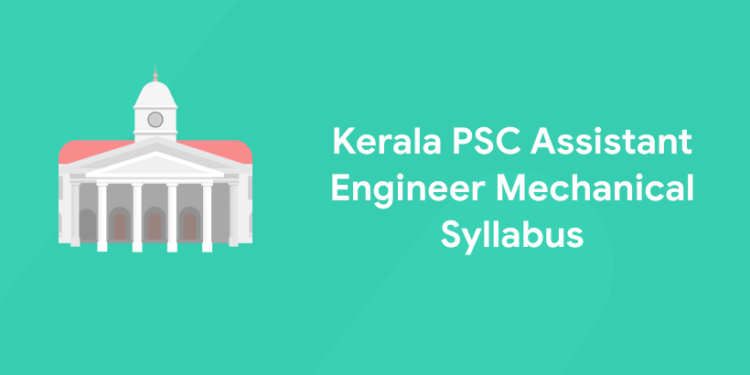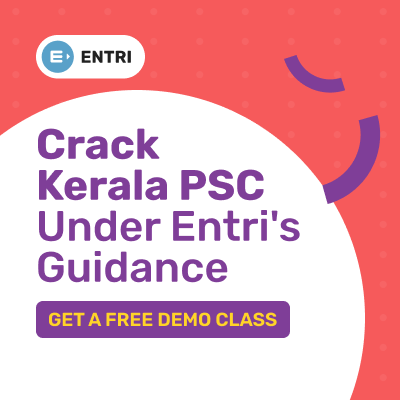Table of Contents
Kerala Public Service Commission issued a job advert for Assistant Engineer Mechanical (664/2022) in December 31, 2023. Applications wish to apply for this post must be filed their application by February 01, 2023 at midnight. For this vacancy in the irrigation department, interested candidates can now submit an online application. Using the Kerala Public Service Commission’s official website, applicants must register once in order to be eligible to submit an application for the position. However, before applying for the post, candidates should understand the basic syllabus for the post. The Kerala PSC Assistant Engineer Mechanical Syllabus 2023 can be found in this blog by applicants. Check the syllabus PDF below.
Prepare for the KPSC Assistant Engineer Mechanical Exam! Get Demo Video Now!
Kerala PSC Assistant Engineer Mechanical 2023: Overview
| Kerala PSC Assistant Engineer Mechanical 2023: Overview | |
| Department | Irrigation Department |
| Name of post | Assistant Engineer Mechanical |
| Scale of Pay | Rs..55200 – 115300/- |
| Number of vacancy | Anticipated |
| Age limit | Must have completed 20 (Twenty) years as on 01.01.2022 |
| Mode of appointment | Direct recruitment |
Kerala PSC Assistant Engineer Mechanical Recruitment 2023: Apply Online
1: Between the period of 1858-1947, how many Viceroys ruled over India?
Kerala Public Service Commission announced various Assistant Engineer Mechanical vacancies under irrigation departments across Kerala. The recruitment drive aims to fill Assistant Engineer in Mechanical posts. The application form for recruitment is available on PSC Thulasi Portal. If interested, visit the Kerala PSC Website or your PSC Thulasi profile on or before Februaru 01, 2023. Make sure you done one time registration to apply for the post. Save your user Id and password to apply for the same as well as other recruitments condcuted under Kerala PSC Department. Follow this article for latest updates
Kerala PSC Assistant Engineer Mechanical Notification PDF
The official notification PDF for Assistant Engineer Mechanical provides the details about the recruitment process, such as the Assistant Engineer Mechanical application form, application fee, eligibility, selection process, steps to apply, etc. See Assistant Engineer Mechanical Notification PDF below.
Kerala PSC Assistant Engineer Mechanical 2023 Eligibility Criteria
Educational Qualification
B.Sc. Degree in Mechanical Engineering of the Kerala University or its equivalent.
OR
B.E. Degree in Mechanical Engineering of the Madras University or its equivalent.
OR
Associate Membership Diploma of the Institution of Engineers (India) in Mechanical Engineering or any other qualifications recognised as equivalent to a degree.
OR
Pass in Section A & B of the Associate Membership Examination of the Institution of Engineers (India) in
Mechanical Engineering.
OR
Any other qualification recognised by the Government as equivalent to B.Sc. Degree in Mechanical Engineering of the Kerala University.
Experience
In the case of First Grade, Second Grade, Third Grade Draftsman / Overseer, they should have rendered not less than 2 years service in Irrigation Department as First Grade, Second Grade, Third Grade Overseers. In the case of Clerks, Typists/Typist – Clerks or Confidential Assistants, they should have rendered not less than 6 years of service as Clerks, Typists/Typist – Clerks or Confidential
Assistants in the Irrigation Department
Age Limit
Must have completed 20 (Twenty) years as on 01.01.2022.Upper age limit is not applicable for this selection.

Kerala PSC Assistant Engineer Mechanical Vacancy 2023
Check below for Kerala PSC Assistant Engineer Mechanical Vacancy 2023. Click on the below link to download Assistant Engineer Mechanical Vacancy 2023 PDF
Kerala PSC Assistant Engineer Mechanical Selection Process 2023
Kerala PSC Assistant Engineer Mechanical Selection will finalize through the following stages.
- Prelims
- Mains
- Interview
- Document Verification
Candidates who clear all the stages will select for the post.
Kerala PSC Assistant Engineer Mechanical Exam Pattern 2023
| Modules | Paper/ Subject | Marks |
| Module 1 | MECHANICS OF SOLIDS | 12 Marks |
| Module 2 | THERMODYNAMICS | 12 Marks |
| Module 3 | FLUID MECHANICS AND MACHINES | 12 Marks |
| Module 4 | METALLURGY AND MATERIAL SCIENCE | 12 Marks |
| Module 5 | THERMAL ENGINEERING | 14 Marks |
| Module 6 | THEORY OF MACHINES AND DESIGN OF MACHINE ELEMENTS |
14 Marks |
| Module 7 | PRODUCTION TECHNOLOGY | 12 Marks |
| Module 8 | INDUSTRIAL ENGINEERING AND MANAGEMENT |
12 Marks |
Kerala PSC Assistant Engineer Mechanical 2023 Syllabus
The syllabus for the Assistant Mechanical engineer exam has been given below:
Technical Knowledge – 100%
Kerala PSC AE Mechanical Syllabus 2023
| Units | Topics |
| Module 1
MECHANICS OF SOLIDS |
Stress and strain, stress-strain diagrams, elastic constants, Poisson’s ratio, Hooke’s law, principal planes and principle stress, Mohr’s circle, calculation of stress, strain and change in length in axially loaded members, thermal stress and thermal strain, torsional deformation of circular shafts, power transmitted by shafts, shear force and bending moment diagrams for beams, bending and shear stresses, normal and shear stress in beams, shear stress formula for beams, deflection of beams, strain energy methods, buckling and stability. Euler’s theory of columns, critical load, equivalent length, slenderness ratio. Rankine’s formula for short columns
|
| Module 2
THERMODYNAMICS |
Thermodynamic systems and processes, properties of pure substances, behavior of ideal and real gases, heat and work, zeroth law of thermodynamics, temperature scales, first and second Laws of thermodynamics, reversible processes, entropy, Clausius inequality, entropy changes in various thermodynamic processes, principle of increase of entropy, available and unavailable energy, availability function, availability and irreversibility, third Law of thermodynamics, thermodynamic relations, Helmholtz and Gibb’s functions, Maxwell’s relations, equations for internal energy, enthalpy and entropy, Clapeyron equation, throttling process, Joule Thomson coefficient, inversion curve, gas mixtures, composition of a gas mixture, mass and mole fraction, Dalton’s law, Gibbs – Daltons Law, equivalent molecular weight and gas constant, properties of gas mixtures – specific heats, internal energy, enthalpy and entropy. Air Standard Cycles, air standard efficiency of Carnot cycle, Otto cycle, Diesel cycle and dual combustion cycle |
| Module 3
FLUID MECHANICS AND MACHINES |
Fluid properties, types of fluid, fluid pressure and its measurement, forces on submerged bodies, stability of floating bodies, energies in flowing fluid, dynamic, static and total head, continuity equation, Eulers equation, Bernoulli’s equation, flow rate measurements – venturi and orifce meters, notches and weirs, pitot tube, Reynolds number, laminar and turbulent flow, Hagen- Poiseuille equation, turbulent flow through pipes, head loss due to friction, Darcy – weisbach equation, Chezy’s formula, losses at entry and exit, sudden expansion and sudden contraction, boundary layer, drag and lift on immersed bodies.
Impact of free jets – stationary and moving vanes, flat and curved vanes, series of vanes, work done and efficiency, impulse and reaction turbines – Pelton wheel, Francis turbine and Kaplan turbine, work done and efficiencies, draft tubes, cavitation, governing and specific speed of turbines. Reciprocating pump – air vessels, cavitation, slip, indicator diagram, work required and efficiency. Centrifugal pump – manometric head, efficiency and losses, priming, specific speed, performance characteristics |
| Module 4
METALLURGY AND MATERIAL SCIENCE |
Classification and properties of engineering materials, metallic bonds, crystal structure, space lattice, types of unit cells, Miller indices, co-ordination number, atomic packing factor, allotropy and polymorphism, imperfections in crystals. elastic and plastic deformation of metals, slip, twinning, dislocation, critical shear stress, Frank-Read source, strain hardening, De-lamination theory, diffusion mechanism, Fick’s Laws, theory of alloys, Gibb’phase rule, solid solutions, Hume Rothery’s rule, equilibrium diagrams, equilibrium diagram of binary alloys, eutectic, eutectoid, peritectic and peritectoid reactions. iron-carbon equilibrium diagram, isothermal TTT diagrams, critical cooling rate, heat treatment processes, hardenability tests, surface treatments, case hardening, carburising, nitriding, cynading, induction hardening, precipitation hardening, recovery, recrystalization and grain growth. Properties, composition and uses of various types of cast iron and steels, effect of various alloying elements. Properties, composition and uses of copper, aluminum, titanium and its alloys. |
| Module 5
THERMAL ENGINEERING
|
Steam engineering – Rankine cycle, boilers, boiler mountings, boiler accessories, steam engine, steam nozzles, steam turbines, multistage turbines. IC engines – classification, air supply system, fuel supply system, ignition system, performance testing, combustion in SI and CI engines, auto ignition, preignition, detonation, octane and cetane numbers, anti knocking agents. Gas turbines classification, regeneration, intercooling, reheating, efficiency and work output. Compressors – classification of compressors, uses of compressors, reciprocating compressor – single stage compressor, equations for work, efficiencies, multistage compressor, intercooler, rotary compressors, fans and blowers. Refrigeration – concept of COP, heat pump, reversed Carnot cycle, refrigeration systems. Properties of moist air, psychrometric chart, basic psychrometric processes, air conditioning systems. Heat transfer – conduction, convection and radiation, Fourier’s law, thermal conductivity, conduction through plane wall and composite wall, black body concept, Stefan-Boltzman law, gray body concept, Newton Rikhman equation, free and forced convection. Heat exchangers – classification, concept of overall heat transfer coefficient, LMTD. Power plants – hydro electric, thermal, diesel and nuclear power plants. |
| Module 6
THEORY OF MACHINES AND DESIGN OF MACHINE ELEMENTS |
Definitions and basic concepts, kinematic and dynamic analysis of planar mechanisms. Belt, rope and chain drives, ratio of belt tensions, power transmitted. Friction clutches – plate clutches, conical clutches. Brakes and Dynamometers – types of brakes, absorption and transmission type dynamometers. Gears – types of gears, terminology, law of gearing, gear tooth profiles, interference and under cutting, calculation of minimum number of teeth, contact ratio, path of contact, arc of contact, gear trains, flywheels, governors, gyroscope, balancing of reciprocating and rotating masses. Free and forced vibrations of single degree of freedom systems, effect of damping, vibration isolation and transmissibility, resonance, critical speeds and whirling of shafts.
Design for static and dynamic loading, failure theories, fatigue strength and S-N diagram, principles of design of machine elements such as bolted, riveted and welded joints, design of shafts, spur gears, rolling and sliding contact bearings, brakes and clutches |
| Module 7
PRODUCTION TECHNOLOGY
|
Casting – types of castings, design of patterns, moulds and cores, solidification and cooling, riser and gating design, casting defects. Principles of welding, brazing and soldering, types of welding, weld defects. Plastic deformation and yield criteria, fundamentals of hot and cold working processes – rolling, forging, extrusion, wire drawing, rotary piercing, rotary swaging, metal spinning. Machining and machine tool operations – mechanics of machining, single and multi-point cutting tools, tool geometry and materials, tool life and wear, economics of machining.Basic machine tools – lathe, shaper, milling machine, drilling machine, boring machine, grinding machine, principles of work holding, jigs and fixtures, turret and capstan lathes, NC/CNC machines and CNC programming. Unconventional machining processes – EDM, ECG, ECM, LBM, USM, AJM, EBM and chemical machining. Principles of powder metallurgy.Metrology and Inspection – Limits, fits and tolerances, linear and angular measurements, Comparators, interferometry, form and finish measurement, alignment and testing methods, tolerance analysis in manufacturing and assembly, concepts of coordinate measuring machine (CMM).Computer Integrated Manufacturing – Basic concepts of CAD/CAM and their integration tools, additive manufacturing |
| Module 8
INDUSTRIAL ENGINEERING AND MANAGEMENT
|
Meaning of management, Taylor’s scientific management, functions of management, organisational structure, authority, responsibility and span of control, line, line and staff, functional, project and matrix organizations. Formation of companies- proprietary, partnership and joint stock companies, private limited, public limited companies, cooperative organizations and government organizations.
Facilities planning – selection of site, factors to be considered, plant layout – process, product, fixed, group technology layouts, principles of material handling, types of material handling equipments, preventive and break-down maintenance, replacement of equipments. Work study – analysis of work methods using different types of process chart and flow diagrams, critical examination, micromotion study and therbligs, SIMO chart, principles of motion economy, determination of allowances and standard time, job evaluation and merit rating, wage payment plans. Production planning and control – importance of planning, forecasting techniques, job, batch and mass production, determination of economic lot size in batch production, functions of production control, routing, scheduling, dispatching and follow up, Gantt charts, inventory models, determination of EOQ and reorder level, selective inventory control techniques, breakeven analysis. Quality control and inspection – process capability, statistical quality control, control charts for variables and attributes, acceptance sampling and operating characteristic curves, system reliability, life testing, bath tub curve. Personal management- objectives and function, recruitment, selection, orientation and training of workers, industrial safety and health, labour welfare, Industrial psychology, labour legislation. Linear programming – graphical and simplex solution methods, transportation and assignment problems, game theory, simple queuing models, CPM and PERT |
Kerala PSC Assistant Engineer Mechanical Syllabus 2023 PDF
How to Download Kerala PSC Assistant Engineer Mechanical Syllabus 2023
- Visit the official website of Kerala Public Service Commission at https://www.keralapsc.gov.in/.
- Select the Recruitment tab on the home page.
- Scroll down to the Download syllabus section.
- Go to the Assistant Engineer Mechanical Syllabus link and click
- The Assistant Engineer Mechanical PDF of the Syllabus will appear.
- Then you can download the KPSC Assistant Engineer Mechanical Syllabus.
- Finally, view The Kerala PSC Assistant Engineer Mechanical syllabus and verify the details.
KSEB Assistant Engineer Previous Year Question Paper PDF
Kerala PSC KSEB Assistant Engineer Mock Test 2023
| Exam | |
| Mock Test Paper – 1 | |
| Mock Test Paper – 2 | |
| Mock Test Paper – 3 | |
| Mock Test Paper – 4 | |
| Mock Test Paper – 5 | |
| Mock Test Paper – 6 |
| Kerala PSC AE Mechanical Exam Information Links | |
| Kerala PSC Assistant Engineer Notification | Kerala PSC Assistant Engineer Mock Test |
| Kerala PSC Assistant Engineer Syllabus | Kerala PSC Assistant Engineer Video Course |
| Kerala PSC Assistant Engineer Exam Date | Kerala PSC Assistant Engineer Study Materials |
| Kerala PSC Assistant Engineer Vacancy | Kerala PSC Assistant Engineer Interview Questions |
| Kerala PSC Assistant Engineer Admit Card | Kerala PSC Assistant Engineer Job Profile |
| Kerala PSC Assistant Engineer Study Plan | Kerala PSC Assistant Engineer Salary |
| Kerala PSC Assistant Engineer Previous Question Papers | Kerala PSC Assistant Engineer Preparation Tips and Tricks |
| Kerala PSC Assistant Engineer Best Books | Kerala PSC Assistant Engineer Result |
| Kerala PSC Assistant Engineer Eligibility Criteria | Kerala PSC Assistant Engineer Cutoff |
| Kerala PSC Assistant Engineer Selection Process | Kerala PSC Assistant Engineer Exam Analysis |
| Kerala PSC Assistant Engineer Answer Key | |













